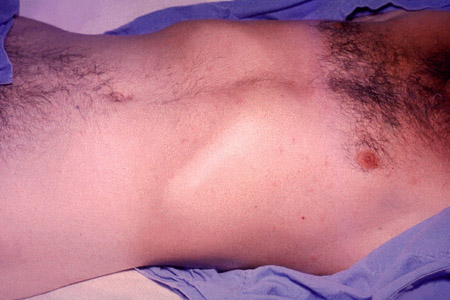History and exam
Key diagnostic factors
common
high fever
Sometimes occurs in a stepwise fashion with 5 to 7 days of daily increments in maximal temperature of 0.5°C to 1°C, with the height of fever usually occurring in the afternoon.
Other diagnostic factors
common
dull frontal headache
This is the most common symptom besides fever (>80% of cases).
abdominal pain
Contrary to common perception, abdominal complaints including diarrhea and constipation are not the main symptoms in this disease.
anorexia
Common symptom that may lead to significant weight loss during the illness.
apathetic-lethargic state
Fever is accompanied in many patients in the endemic areas by an apathetic-lethargic state. It is less often seen in the travel population.
constipation
Although most physicians associate typhoid fever with diarrhea, constipation is a more common complaint.
cough
Cough is a relatively frequent symptom, while secondary pneumonia is a rare occurrence.
diarrhea
Usually mild diarrhea in about 50% of cases. Note: an acute febrile illness with severe watery diarrhea usually indicates nontyphi bacterial diarrhea (e.g., other Salmonella, Shigella, Escherichia coli)
malaise
Malaise and prostration are common complaints.
nausea
Nausea and loss of appetite are common complaints.
prostration
Malaise and prostration are common complaints.
uncommon
chills
Patients typically present after the onset of fever with influenza-like symptoms including chills.
hepatomegaly
Hepatomegaly and splenomegaly may exist.
pneumonia
Although cough might often occur, pneumonia is not common.
relative bradycardia
Although relative bradycardia is often mentioned as an important sign in typhoid fever, this sign is neither sensitive (because in many patients with typhoid it is not present) nor specific (because it may occur in several other febrile illnesses).
rigors
Chills are a common complaint, although true rigors are rare.
rose spots
Blanching erythematous maculopapular lesions usually 2 to 4 mm diameter are reported in 5% to 30% of cases.[Figure caption and citation for the preceding image starts]: Rose spots on the chest of a patient with typhoid feverCDC/Armed Forces Institute of Pathology, Charles N. Farmer; used with permission [Citation ends]. [Figure caption and citation for the preceding image starts]: Rose spots on abdomen of a patient with typhoid feverCDC/Armed Forces Institute of Pathology, Charles N. Farmer; used with permission [Citation ends].
[Figure caption and citation for the preceding image starts]: Rose spots on abdomen of a patient with typhoid feverCDC/Armed Forces Institute of Pathology, Charles N. Farmer; used with permission [Citation ends].
Requires vigilance and experience to diagnose and their incidence therefore varies markedly between series.
Rare in S paratyphi A infection.
splenomegaly
Hepatomegaly and splenomegaly may exist.
Risk factors
strong
overcrowded living in endemic areas
Overcrowded conditions with no adequate sewage system increase the risk of infection.
poor sanitation/untreated water in endemic areas
Mixing sewage water with drinking water and irrigation of fields with sewage water leads to contaminated water and food.
poor personal hygiene in endemic areas
Recent typhoid infection in the household, no use of soap for hand washing, sharing food from the same plate, and no toilet in the household double the risk of infection.[35]
visiting endemic countries (e.g., Indian subcontinent, Mexico)
Risk is even higher in travelers visiting friends and relatives: that is, immigrants who return to visit their homeland.[17]
travel to areas with poor sanitation within endemic countries
Travel to rural areas with poor sanitation is associated with a higher risk.
ignoring hygiene rules while traveling in endemic countries
Not following food and water precautions and not receiving pre-travel consultation increases the risk 10 times.[36]
travel to the Indian subcontinent
The overall risk of typhoid infection in travel to the Indian subcontinent is 18 times higher than to any other geographic area.[5]
longer duration of stay in endemic country
Around 60% of cases in US travelers involved people staying for up to 6 weeks, while only 5% of cases had a short visit (<1 week).[37]
weak
antacid/proton-pump inhibitor (PPI) treatment
Use of this content is subject to our disclaimer